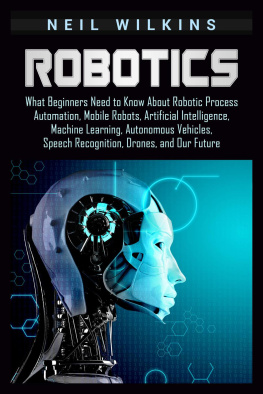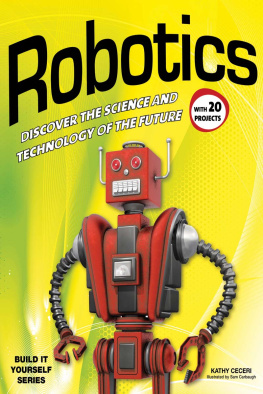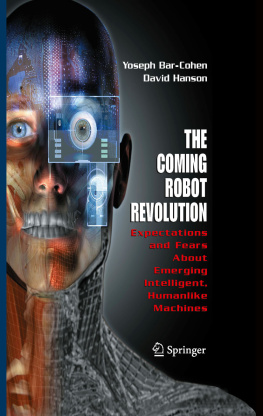
Tales from a Robotic World
Tales from a Robotic World
How Intelligent Machines Will Shape Our Future
Dario Floreano and Nicola Nosengo
The MIT Press
Cambridge, Massachusetts
London, England
2022 Massachusetts Institute of Technology
All rights reserved. No part of this book may be reproduced in any form by any electronic or mechanical means (including photocopying, recording, or information storage and retrieval) without permission in writing from the publisher.
The MIT Press would like to thank the anonymous peer reviewers who provided comments on drafts of this book. The generous work of academic experts is essential for establishing the authority and quality of our publications. We acknowledge with gratitude the contributions of these otherwise uncredited readers.
This book was set in Adobe Garamond Pro by New Best-set Typesetters Ltd.
Library of Congress Cataloging-in-Publication Data
Names: Floreano, Dario, 1964author. | Nosengo, Nicola, 1973author.
Title: Tales from a robotic world : how intelligent machines will shape our future / Dario Floreano and Nicola Nosengo.
Description: Cambridge, Massachusetts : The MIT Press, [2022] | Includes bibliographical references and index.
Identifiers: LCCN 2021058944 | ISBN 9780262047449 (hardcover)
Subjects: LCSH: Technological forecasting. | TechnologySocial aspects. | RobotsSocial aspects. | Artificial intelligenceSocial aspects. | RobotsFiction.
Classification: LCC T174 .F56 2022 | DDC 601/.12dc23/eng/20220218
LC record available at https://lccn.loc.gov/2021058944
10 9 8 7 6 5 4 3 2 1
d_r0
Contents
Introduction
Look around you. Do you see any robots? If you live in a rich country, theres a good chance that your answer is, Yesa vacuum cleaner. You may see computers, smartphones, tablets, TV sets, voice-powered assistants, and other pieces of technology in the room where you are reading this book. But its a safe bet that theres nothing around you now that you call a robot, except for that vacuum cleaner.
And yet they should be everywhere. It has been fifteen years since Bill Gates, in a 2008 cover article in Scientific American, predicted that robots would soon enter every home, just like personal computers had done a few years earlier. Since then, countless news stories have told us that friendly, collaborative, humanoid robots would soon work as nurses in our homes and butlers in our bars. We were promised autonomous robots that we could send to places we would rather not visit ourselves, where they would figure out by themselves what to do.
We keep seeing hints of a robot revolution just around the corner. For a few years by now, weve been watching with amazement each new video from Boston Dynamics, the US company that makes humanoid and dog-like robots capable of all sort of stunts: walking in the snow, dancing, doing parkour or gymnastics with impressively natural movements. When Elon Musk, in summer 2021, announced plans to build a humanoid robot called Teslabot, he made it sound easy. After all, he noted, Tesla and others autonomous vehicles are robots on wheels. Though driverless cars are not ready for full deployment yet, their development is accelerating the evolution of sensors and of neural networks and algorithms that collect data to make decisions in real time. Interestingly, Tesla is not the only carmaker making a move toward robotics: in 2021, Hyundai bought Boston Dynamics. The technology is there, Musk argued, to build at least a prototype of a humanoid robot that can move out of your house, go to the grocery store, and pick up the items that youve asked for. If it isnt there yet, Musk seemed to imply, it is because no one has tried hard enough or thrown enough money at the problem.
Musk has a history of succeeding where others repeatedly failedsuch as sending a spacecraft to space with reusable rockets or making electric vehicles affordable and cooland he should be taken seriously. And yes, those Boston Dynamics videos are very impressive. But despite what those announcements and demos may suggest, theres still a lot to do before having robots in homes, streets, citiesbefore your room will be filled with robots ready to do work for you and that you can interact with just as easily as you do with your smartphones.
The reason those robots are not pervasive yeta reason that Bill Gates overlooked fifteen years ago and others keep overlooking todayis that in order to build robots, we need more than the increasing computing power, component miniaturization, and engineering wizardry that gave us computers, smartphones, and smart wearables. We need a new science. The bad news is: a new science takes a lot of time. The good news is: new science is happening in dozens of laboratories around the worldand that is the story we tell in this book.
The fact that there are few or no robots in your home does not mean that there are no robots at all out there. Modern manufacturing would be unthinkable without robots: more than 3 million industrial robots were operational in factories by the end of 2020, 32 percent of them purchased by car manufacturers. Robots are roving, drilling, and flying on Mars, though they are mostly piloted by humans on Earth.
Most of these robotsthe ones that we can buyare built with the technology of the appliances that they are meant to replace; therefore, they have only a limited understanding of their surroundings and limited decisional autonomy. You cannot tell them or show them what to do. You have to program their moves or, in the best case, select preprogrammed actions from an app. And unlike personal computers, they are not general-purpose machines: they may do one thing very well but cannot easily switch to a slightly different task. Ask them to repeat the same action again and again, and they are great. Ask them to improvise, learn from experience, gain human trust, and they get stuck. In other words, robots are great at a few things, but they suck at all the rest. Worse, they suck at things that weand indeed much simpler animalscan do effortlessly. These limitations became obvious, for example, when a devastating earthquake and tsunami hit Japan in 2011 and a disaster at the Fukushima nuclear plant ensued. Japan, a robotics superpower if there ever was one, tried sending robots instead of humans to check the site of the nuclear accident, only to discover that they were not up to the task. Not even close.
And yet, think for a moment of what robots could do for uswhat problems they could solve, what risks they could take for us, what places they could goif they only resembled living beings a bit morefor example, if they could understand the meaning or function of what they see, if they could engage with us as other people or pets usually do, or if they could autonomously coordinate with other robots to carry out tasks that a single robot cannot handle, as human and animal societies do. What kind of world could we build with those robots?
In this book, we imagine that world, and we tell what is brewing in labs around the world with the help of brilliant and visionary scientists and engineers who want to make it possible.
Every chapter is built around a fictional story set a few decades into the future, intersected with nonfictional accounts of the research that, here and today, is paving the way for that future. A few words on those futuristic stories. First, we are not novelists, and we do not have the ambition to rival any of the great science-fiction literature on robots and artificial intelligence, a genre mastered by great writers such as Isaac Asimov, Philip K. Dick, and Ian McEwan to name a few. Rather, we use fiction to help our readers see the bigger picture and understand what is at stake with robotics research today. Second, we are not trying to predict the future, but neither do we let our imagination run free as a true novelist would. Each story is visionary enough to get you interested in the science and technology behind it, but grounded enough in the reality of current science and engineering to think that, if all goes well and all of roboticists efforts pay off as they hope, it would be technically possible for that scenery to take place in that specific time frame. Third, just like the nonfictional parts of the book, the fictional stories owe a lot to the work of the international robotics community, building on ideas and visions that are shared at conferences, in publications, and in informal discussions with colleagues.
Next page







